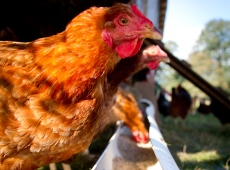Poultry Nutrition
 Free-ranging birds supplement their diet with varying quantities of grass. Birds obtain nutrients from pasture, from insects and other small invertebrates and from small seeds, fruits and berries. Currently it is not known how important each of these sources of nutrition is likely to be, although it has been estimated that the potential contribution of pasture (grass, insects and worms) is not negligible (except in winter), but it is probably small (ADAS, 2005; Charles, 1984, Hill et al., 1988). Of course, there are also other benefits beside those concerned with meeting the birds’ nutritional needs, such as those related to product quality (Ponte et al., 2008) and bird welfare..
Free-ranging birds supplement their diet with varying quantities of grass. Birds obtain nutrients from pasture, from insects and other small invertebrates and from small seeds, fruits and berries. Currently it is not known how important each of these sources of nutrition is likely to be, although it has been estimated that the potential contribution of pasture (grass, insects and worms) is not negligible (except in winter), but it is probably small (ADAS, 2005; Charles, 1984, Hill et al., 1988). Of course, there are also other benefits beside those concerned with meeting the birds’ nutritional needs, such as those related to product quality (Ponte et al., 2008) and bird welfare..
Nutritional Benefits of Pasture
Pasture consumption is influenced by a number of factors, including the amount of time spent outdoors, foraging behavior, plant species, stage of growth, palatability, and nutritional content of the plants and nutritional needs of the birds (Moyle et al., 2014). Breed may also be important and slow-growing breeds adapted to outdoor conditions will utilize forage more effectively (Nielsen et al., 2003).
The quality of the pasture will be related at least in part to the plant species composition. It is likely that the pastures used by many free-range poultry flocks will have been established for use by cattle, sheep or goats, and may well contain species that are not ideally for poultry production (Moyle et al., 2014). If poultry consume largely grass, the nutritional value derived is likely to be relatively poor. While it would constitute a source of energy and fibre, the protein contribution would be low at 0-5% of the total requirement (Walker and Gordon, 2003). However, birds that are allowed to freely range will also consume a higher proportion of insects and seeds than those that are enclosed but with access to forage (Amaka Lomu et al., 2004). It has also been shown that pasture intake promotes growth by improving the consumption of the cereal-based feed, even though the intake of forage dry matter was low (Ponte et al., 2008).
Providing Forages
Providing chickens with forages to supplement their diet can have positive welfare impacts. Feeding both pea and maize silages, and carrots, were all shown to significantly reduce mortality, feather pecking, including severe pecking and to improved plumage quality of layers (Steenfeldt et al., 2007). Providing straw as forage and feed in mash form has also been shown to reduce feather pecking (Aerni et al., 2000).
The American Pastured Poultry Producers Association (APPPA) is a membership based organization that provides education and producer networking opportunities for pastured poultry farmers http://apppa.org/
Nutritional Deficiencies
Many nutritional deficiencies of poultry show similar symptoms, such as reduced growth, poor feathering and weakness. Consequently, it is not always possible to determine from symptoms the precise deficiency. Diet analysis, examination of the management system and necroscopy may be required to enable accurate diagnosis. When evaluating the compositional quality of diets, it is important to note that some ingredients may be unstable or unavailable in various forms, and that there may be associative effects where the availability of some nutrients depends on the presence or availability of others. Environmental conditions, the presence of toxins, the incidence of disease and the production status of the birds may also be influential in determining the availability and requirement of specific nutrients.
Some nutritional deficiencies are temporary and reversible upon diet correction.
There are more than 36 nutrients that are absolutely critical to poultry that must be present in diets at appropriate levels and balance.
The nutrients required by poultry can be divided into four categories:
• The major nutrients: water, energy, protein, essential amino acids and essential fatty acids;
• The major minerals: calcium and phosphorus, magnesium, potassium, sodium and chloride;
• The trace elements: including iodine, selenium, iron, copper, manganese, zinc and many others;
• The vitamins: vitamins A, D, E and K, folic acid, thiamin, riboflavin, niacin, pantothenic acid, pyrodoxine, biotin, vitamin B12 and choline.
Feedipedia
is an open access information system on animal feed resources that provides information on nature, occurrence, chemical composition, nutritional value and safe use of nearly 1400 worldwide livestock feeds www.feedipedia.org.


 British English
British English

Comments are closed.